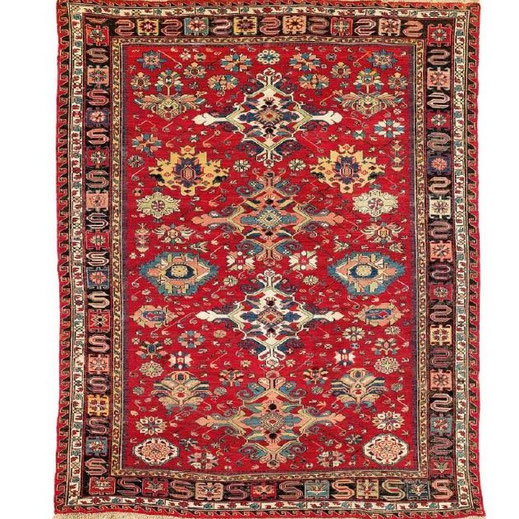Soumak Four Medallions, East-Caucasus, Kuba, Early 19th Century
The East Caucasian Khanate of Kuba was occupied by Czarist troops in 1806 and became a province of the Russian Empire, the ""Shamakha Governorate"", in 1816. Pile rugs, kilims and complex flatweaves have been made in the region for centuries. Commercial production of sumakhs in Kuba workshops began around 1870. They used traditional designs in combination with an increasing number of chemical dyes (initially only mauveine and fuchsine; later other, even more garish colours were added), adapting the formats to the requirements of foreign purchasers, which quickly led to a complete degeneration of sumakhs.
This Soumak / sumakh has nothing in common with the late examples that have survived in large numbers. The design of four large diamond-shaped medallions aligned on the central axis, flanked by various palmettes along the sides, employs motifs seen in 17th-18th century Caucasian workshop carpets; here they have been translated into a geometric style adapted to the weaving technique. In the narrow main border, cartouches alternate with S-shaped abstract dragon figures. Only a very few small-format examples of this design group have survived.
Published as early as 1910 in Reinhart von Oettingen‘s postcard collection as a ""Meisterstück des 19. Jahrhunderts (19th century masterpiece)"", it became well-known among a wider community of enthusiasts when republished in Grote-Hasenbalg‘s influential book, ""Der Orientteppich. Seine Geschichte und seine Kultur""
Armenian Azerbaijani rugs making is part of UNESCO´s Masterpieces of intangible heritage. in great condition, explendid vivid colours, high quality Caucassian wool.
298cm x 197cm.
24.000,00 €
incl. VAT, shipping costs apply
Free shipping to the following countries: Show more Show less
- Available
- Delivery in 5-30 days1







